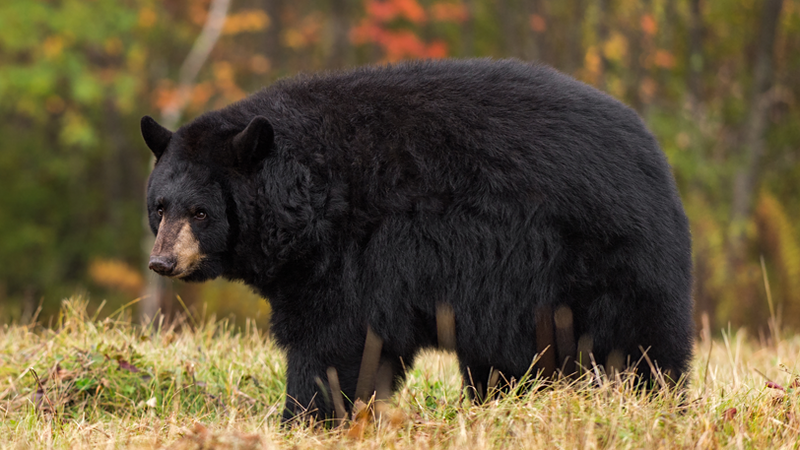Randy Zellers Assistant Chief of Communications
LITTLE ROCK — Arkansas’s bear season kicks off Sept. 13, and hunters should check out some of the new regulations from the Arkansas Game and Fish Commission if they plan to be loaded for bear this year in The Natural State.
Get “Permit”-tion
Both residents and nonresidents are now required to have a bear permit to pursue and check a bear in Arkansas. The new Resident Bear Permit (TBEAR code in the license system) is free. The new Nonresident Bear Permit (NRB) costs $300. These permits are in addition to a Sportsman’s License (license code CS or RS) for residents or a Nonresident Annual Hunting License (NBG) for nonresidents. Both permits are available through the AGFC’s new license system online, through license vendors and through the AGFC’s mobile app.
According to AGFC Bear Program Coordinator Myron Means, the permits are an effort to learn more about bear hunters’ experiences and successes in The Natural State.
“We know how many bear hunters are successful each year through game checks, but these permits will give us critical data on the number of people actually pursuing black bears in Arkansas. We can also reach out to our bear hunters through the contact information on these permits to learn more about all the hunters who pursue bears here.”
Pulling Teeth (and Hair)
Successful hunters also must submit a premolar tooth from the bear they harvest as part of the checking process. This isn’t a new requirement, but is one of the most overlooked portions of checking their harvest hunters forget during their excitement of tagging a bear.
When a hunter initially checks their bear, they will receive a packet in the mail from the AGFC within a few days. They will have seven days from the arrival of that packet to pull and return a premolar tooth to the AGFC.
“We cut the tooth and count rings on it similar to aging a tree by growth rings,” Means said. “It’s easiest to pull the tooth right after harvest and save it until your packet arrives in the mail. That way you don’t have to thaw out a frozen skull or make a trip to the taxidermist to retrieve it or get a ticket for failure to finish checking your bear.”
The tooth packet also will include a separate envelope for a hair sample. While this is currently voluntary, it takes seconds to collect.
“The hair sample is needed to continue building our genetic database of bears,” Means said. “Our research staff is really stepping up our game in learning more about our bears and differences in the population around the state on a genetic level.”
Means stresses that hair samples should be pulled from the bear’s hide, not cut, as the hair follicles are the portion of the sample most needed for analysis.
An instructional video on how to collect these samples is available at the AGFC YouTube Page.
Liver Samples Wanted
AGFC State Wildlife Veterinarian Dr. Jenn Ballard says hunters also can help bear research by collecting another sample from each harvested bear. The AGFC is studying an apparent increase in mange in Arkansas bears, and liver samples from bears with and without mange are important to compare any environmental differences that may be affecting the bears.
“Whether the bear has mange or not, we really would like to get a sample of the bear’s liver,” Ballard said. “Hunters can cut a piece about the size of a softball and place it in aluminum foil or a zip-sealed bag. They can then submit it through one of the dozens of chronic wasting disease sample containers throughout the state for deer hunters.”
Ballard says the locations of all CWD containers are available and updated at www.agfc.com/CWD.
“Also, anyone who sees a bear with signs of mange can report it to the AGFC Wildlife Health Program ([email protected]),” Ballard said. “Those reports and liver samples will help us track the disease throughout the state.”
Look Close
Means adds one last precaution for hunters taking advantage of this year’s early bear season opener.
“We opened bear season earlier to try and get ahead of the acorn drop this year and provide added success for bear hunters,” Means said. “When we’ve had early opening days in the past, we did have some concerns about a high percentage of female bears being harvested. We prefer hunters to harvest the male segment when they can, so the females can replenish the population.”
Means says one surefire way to separate male bears from females is the presence of cubs.
“If the bear has cubs with it, it’s a female and those cubs need to overwinter with her for another year,” Means said. “After that it can be a little trickier to determine their sex.”
Means teamed up with social media influencer Clay Newcomb to develop a video highlighting ways to determine a bear’s sex using trail camera footage and key markers.
“Identifying male from female and adult from yearling can be difficult for some hunters when it comes to bears, but most of our bear hunters tend to be more avid and willing to take a few extra steps to promote the resource,” Means said. “With these precautions in place, I’m hopeful that we can continue to offer these early seasons and not impact the resource.”
Visit www.agfc.com/bear for more information on bears and bear hunting in Arkansas.







